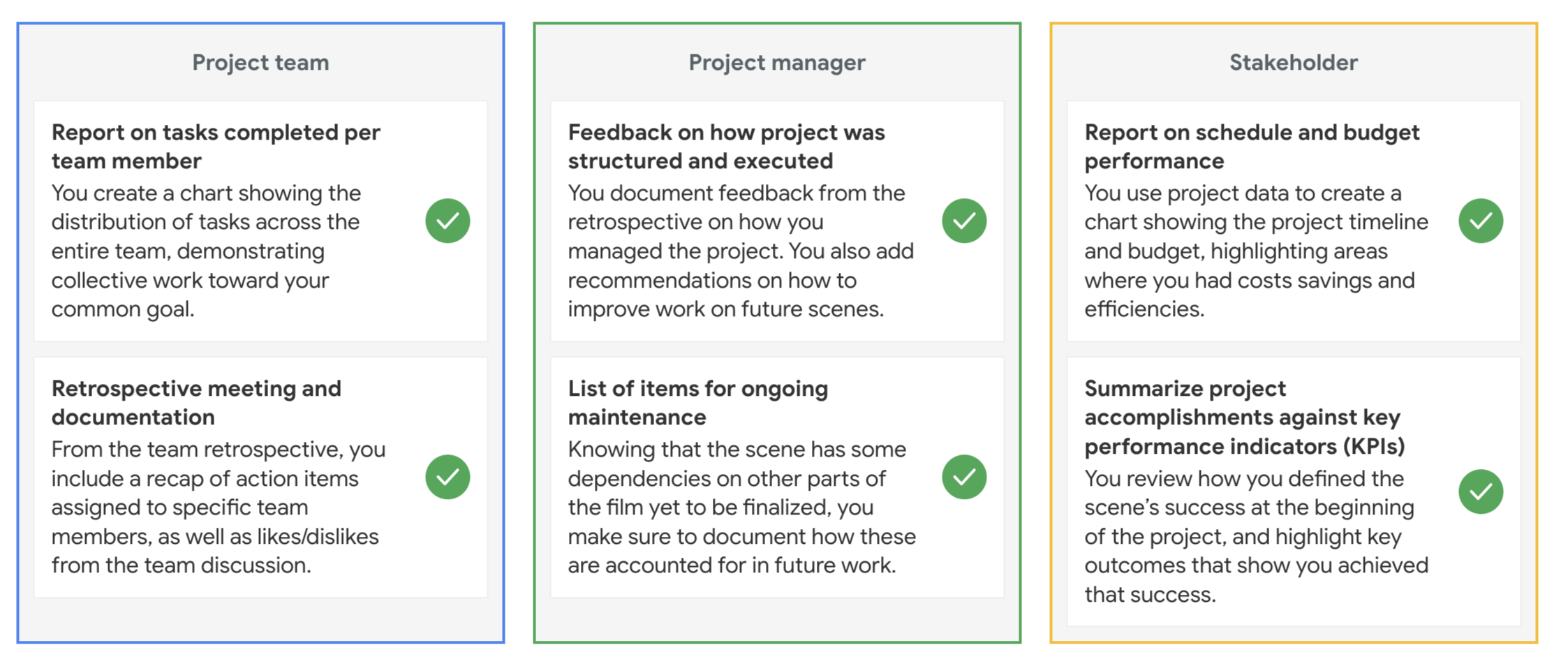Closing a project
- All work is done.
- All agreed-upon project management processes have been executed.
- You have received formal recognition and agreement from key stakeholders that the project is done.
Oversights or skipping steps in the closing phase of a project can:
- Impact the product's or service's scheduled launch dates.
- Put your organization at legal risk.
- Result in significant financial losses to your organization.
- Undermine your team's credibility, and yours.
- Damage your relationship with the customer or client.
Demonstrating project impact to stakeholders
Highlight key performance areas
The purpose of your impact report is to show your key stakeholders the impact your project had on the organization. Goals, objectives, budget, schedules, and key performance indicators (KPIs) need to be determined at the beginning of your project. Your impact report should demonstrate how well you did against those early targets. In your report, you should also answer the question: What was the problem we were trying to solve, and how did we solve it? This will help you showcase the value your project outcome brought to the business.
Highlight these key performance areas to demonstrate to your stakeholders how you achieved successful results and outcomes:
- First, describe the goals and objectives you set for the project and what you hoped to have achieved by the end.
- Then, describe how you met those objectives against your KPIs. A KPI is a measurable value that demonstrates how effective a company is at achieving their objectives. In your impact report, review how you defined the success of your project at the beginning, and highlight the outcomes you achieved that demonstrate this success.
- Finally, showcase your schedule and budget performance by outlining your cost savings and efficiencies. Demonstrate that you met the deadlines set in your project scope and that your project was completed within budget.
Use metrics to showcase your results
Use facts and statistics to highlight the results you achieved related to the performance areas described in the section above. Examples of common metrics you might include to demonstrate a positive impact could include:
- Improvement in schedule performance
- Revenue growth
- Positive return on investment (ROI)
- Increased external user counts
- Increased percentage of internal users
- Cost vs. margins
- High percentage of customer satisfaction
- Reduction in overhead
- Reduction in technical issues
- Time saved
Metrics and data points are one of the best ways to present impact. Throughout your project, collect data and track progress in each of the areas you want to measure. If you can complement your metrics with the appropriate visuals and tie them back to the project's larger goals, you can quickly demonstrate your project's success and value.
Prepare an effective impact report presentation
An effective presentation can help your stakeholders understand your project's impact. In order to successfully convey all of the information you have prepared:
-
Be concise. While you should share metrics that illustrate how you achieved your project goals, you do not need to include extraneous details. For clarity, organize information by using bullet points instead of paragraphs.
-
Understand your audience. Make sure that your report does not use too much technical language or jargon to help your stakeholders understand it.
-
Use visuals. Use a digital presentation application, such as Google Slides, Microsoft PowerPoint, or Canva to present your impact report. Add diagrams, such as charts and graphs, to illustrate your results. Use images to add visual interest. Add icons to draw attention to information and help your stakeholders quickly understand information.
-
Describe your learnings. Discuss lessons you learned during the course of the project and any areas you have identified for improvement.
-
Keep your stakeholders engaged. Grab and keep your stakeholders' attention by varying the way that you present your data:
- Show: Play videos of demos, testimonials, or case studies.
- Storytell: Tell a story or anecdote related to the data in the report.
- Engage: Ask for audience participation through questions, surveys, or quizzes.

Closeout report
Be sure to include the following elements in your completed closeout report:.
- An executive summary of the project
- Key accomplishments and completed objectives
- Lessons learned (what went well, what went wrong, and how to improve)
- Open items to address
- Next steps for the service
- Links to project resources
Exemplar
-
The project closeout report includes a date, status, project team members and the project duration.
-
There is a brief Executive Summary that outlines the scope of the project, the completed deliverables, and issues that arose.
-
The Key Accomplishments section includes tasks and milestones the team reached during the project. These include not only the work the team did, but the goals and results of their efforts. For example, "Implemented feedback from customer surveys, increasing on-time deliveries by 10% and satisfaction with customer service by more than 42%."
-
Lessons Learned include things that went well and issues that arose throughout the project. For example, the employee training in advance of launch went well, which boosted employee efficiency. Things that went wrong include both the problem and the solution: "On-time deliveries went from 80% to 90% during the test launch, by hiring more drivers and reassessing delivery routes."
-
The Open Items section includes areas of the project that need improvement, as well as operations procedures that require ongoing maintenance.
-
The Next Steps and Future Considerations section includes next steps that future project managers should act on. For example, "Create an ongoing training schedule for employees."
-
The Project Timeline includes start and end dates for each task and milestone.
-
The Resources and Project Archive section links to important project documents.